| Beaches and dunes have natural periods of growth and erosion. Many people believe that we do not give our beaches enough space to wax and wane naturally. Once property is threatened, the beach is lost. | ||
| When the beach erodes and the sand disappears, people's first reaction is to bring new sand in from elsewhere. Little attention is paid to the reasons why the sand disappeared, and beach erosion continues. | ||
| By draining the beach, the sand is able to dry and the sea wind is able to re-create a dry beach. It is a cheap and effective way for beaches whose sand cannot dry easily. | ||
| Where beach erosion appears unstoppable, sea walls are built to protect property, business and life, but the natural beach disappears. | ||
| Beaches strung between headlands are less prone to erosion from long-shore currents. Groynes (groins) are artificial headlands between which sand accumulates. But they cause problems too and look ugly. | ||
| Jetties are long dams jutting out in the sea, designed to keep the entrances to harbours open and navigable. They also cause serious beach erosion. | ||
| Breakwaters are artificial barriers erected parallel to the shore. Sand gets trapped behind them. But extreme events destroy them. A new fad is the breakwater for surfing. | ||
| Sand is bountiful in the sea but mining it attracts opposition, but is it really damaging the beaches?. With our newly found insights, we can support mining in certain places and conditions. |
| The line in the sand
Beaches and dunes grow in years of much sea wind, fine weather and few big storms. They shrink in years with opposite conditions: little sea wind, bad weather and many large storms. A succession of bad years may see the water's edge move inland further than ever thought possible. Sections for building may have been surveyed just after many favourable years, resulting in property boundaries further seaward than an imaginable line in the sand, marking the space necessary for cyclical variation plus a safety margin. But lack of insight and town planning has often allowed people to build far past this line, too close to the water. People have drawn their own lines in the sand. |
The problem with the concept of the 'line in the sand' is that nobody appears to be able to guarantee where that line runs. Should building therefore be prohibited from all dunes? Another problem is that beaches appear to be eroding past all conceivable 'lines in the sand' and that permanent erosion appears to have set in. As we have seen before, this has identifyable (human-induced) reasons.
Even if the dunes were marked in risk zones of say, 25, 50, 100, 200 years life expectancy, businesses would still want to build close to the water because they can simply mark their prices up, in order to write buildings off in a much shorter time. The free market system is thus not able to save beaches.
| Renourishment
When a beach erodes and the sea starts to threaten properties, the first engineering solution is to bring in new sand It is called renourishing the beach. Many beach resorts suffer from beach erosion because their tall buildings lift the sea wind from the beach. Also the natural dune system has been flattened and built over. Such beaches can no longer repair themselves. They are effectively dead. |
Engineers pump sand from offshore or transport it in by barge. They prefer coarse sand because it stays on top of the old fine sand, stopping it from being blown away and giving the impression that it also remains there longer. But it does not feel as pleasant as the old sand and it disappears rapidly seaward. Renourishment needs to be done every five to ten years, involving high costs. It puts more sand near the beach, creating sand bars and causing the beach to lay flatter, eventually no longer able to dry. No attention is paid to remove the causes of the beach erosion.
The process of beach renourishment is well known and has been documented
extensively. But it can never offer a lasting solution. We have to ask
ourselves now, how to design coastal settlements and resorts in such a
way that their dunes and beaches remain natural and healthy. The free market
does not appear capable to do so.
| The cost of beach renourishment
in Florida (USA) may serve as an example. Beach renourishment became popular
since the early seventies.
Of the 1242 km of beach, about 195 km (15.7%) are eroding with 124 km critically. From the mid 1960s to 1998, 91 beaches totalling 514 km have been renourished. A total of 115 million m3 of sand, costing over one billion dollar have been used for 251 renourishment programmes. On average, 200 m3 of sand were used to renourish one metre of beach, for a cost of about $10 per m3 at the value of the US dollar in 1996. Renourishment was often done with sand dredged from navigation
channels and these projects (31%) were paid for by navigation departments.
58% of the projects were funded by the state (federal funds) and aboutt
4% were funded privately.
Source: Luciana S Esteves, International Coastal Symposium 2000. |
 This
aerial view shows Miami Beach on left in 1982 when 14 million cubic metres
of sand were applied and on right on 6 Nov 1993 showing that most of the
sand had disappeared. Groynes have been built in an attempt to slow the
erosion but the beach has no dunes left and the tall buildings deprive
it of the necessary sea wind to accumulate a buffer of dry sand. No amount
of wet sand can protect property in the long run. Note that by 1993 nearly
half the shoreline was protected by sea walls. Note also how property has
expanded seaward. This
aerial view shows Miami Beach on left in 1982 when 14 million cubic metres
of sand were applied and on right on 6 Nov 1993 showing that most of the
sand had disappeared. Groynes have been built in an attempt to slow the
erosion but the beach has no dunes left and the tall buildings deprive
it of the necessary sea wind to accumulate a buffer of dry sand. No amount
of wet sand can protect property in the long run. Note that by 1993 nearly
half the shoreline was protected by sea walls. Note also how property has
expanded seaward.
Pictures: Cyril Zaneski, Florida. courtesy of Mr Burgess, Omaha, NZ. [A note from James Houston, 16 Dec 2012:"The photographs you have of beach nourishment performance at Miami Beach are reversed. The photo that says it was taken in 1993 is Miami Beach in the late 1970s prior to beach nourishment. The Miami Beach nourishment looks today about like it did right after the beach nourishment and is considered one of the most successful beach nourishment projects in history. It completely rejuvenated Miami Beach. There are all kinds of articles and pictures on the internet that verify what I am saying." ] |
Beach drainage
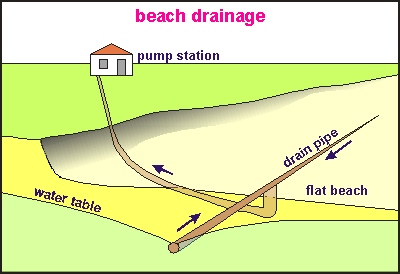 A
very recent development is that of draining beaches. The idea is to place
a drainage pipe under the sand below the high tide level. The drainage
pipe conducts water to a collection point from where it is pumped out.
The water is then led back to the sea. This method recognises that many
beaches are sick because their sand cannot dry. These beaches usually lie
too flat. By draining the high tide region, the water table is lowered
and the sand has a better chance to dry. The sea wind completes the renourishment. A
very recent development is that of draining beaches. The idea is to place
a drainage pipe under the sand below the high tide level. The drainage
pipe conducts water to a collection point from where it is pumped out.
The water is then led back to the sea. This method recognises that many
beaches are sick because their sand cannot dry. These beaches usually lie
too flat. By draining the high tide region, the water table is lowered
and the sand has a better chance to dry. The sea wind completes the renourishment.
The method is quite simple to implement, requires no visible structures or mechanical transportation of sand, and the sand that is already in the sea is used. Energy can be saved by pumping only during the low tide and by day when the sand can dry. For beaches with other problems such as sea wind obstruction or crusting, this method may be less successful. |
What is perhaps surprising of this beach restoration method, is that
it works while almost completely invisible. Although it does not address
the causes of beach degradation such as tall buildings and trees, sand
contamination and more, it does change the balance of the physical factors
that maintain the beach. But when pumping is stopped, the beach degrades
back to its previous state. Storms of course, cause the beach to recede
temporarily.
Consider the three main components contributing to beach maintenance:
draining, drying and blowing. When either becomes weakened, it can be compensated
for by increasing the functioning of one of the remaining components. Of
these, drainage is the easiest to enhance. Surprisingly, a previously 'sick'
beach can be coaxed to produce over 30m3 of sand per metre of beach per
year!
Another interesting aspect of the success of beach draining is that it refutes the theory that beaches are degrading because of rising sea levels. Sea levels may rise, but beach draining can always produce sand to form a beach higher up. A healthy beach can do likewise, without technological assistance.
| Sea walls
People build sea walls as a last resort in their defence against the sea, or to reclaim land from the sea, or to protect low lying settlements from hurricanes. The idea is quite simple and many coastal property owners have been forced to reinforce their seaward boundaries. |
Where people go wrong is that they cannot imagine the strength of a
hurricane compared to every day exposure. (See also Oceanography/extreme
events). For example, when fine weather waves of about 1m height pound
on the beach, they dissipate an average of 10kW per metre of beach or the
power of a small car at full throttle, every five metres. (Ref Douglas
L Inman in Oceanography, the last frontier, 1974)
A three metre wave, by no means abnormal, dissipates about ten times
that energy. As the energy in the waves increases with the fourth power
of wind speed, a storm of 60 knots can produce waves of 15-20m (250 times
the sample energy) and hurricanes of category four, with winds of 250 km/h,
is again over ten times stronger. So an extreme event can dissipate hundreds,
even thousands of times more energy than everyday events. Engineers, used
to safety factors of three, have difficulty calculating structures that
will stand the anger of the sea or these become unaffordable.
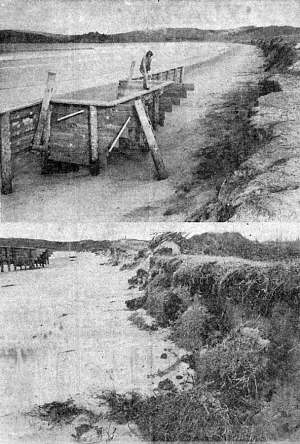 |
When Omaha Beach, north of Auckland, New Zealand eroded
suddenly after a storm in 1975, engineers decided to build a seawall hugging
what remained of the shore. They assured that it would be strong enough
to last all storms and that it would provide permanent protection to worried
property owners.
Hardly one year later, another storm carved out 10m behind it and once again 30m and the whole structure was destroyed by waves. With hindsight, the exercise was rather naive, considering how much experience engineers world wide have had in constructing seawalls (but at a very much higher cost). The Dutch would certainly smile about this story. Pictures: H E Bridges, Omaha
|
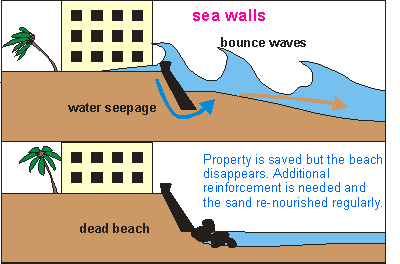 Another
commonly overlooked design shortcoming is that extreme events do not only
arrive with bigger waves but also with a storm surge that raises the water
level. Thus at some time, it is unavoidable that the sea crashes over the
wall and the water has to go somewhere, usually back to the sea. During
its return trip, the wall is attacked from behind, resulting in deep gouging
of the soil placed behind it. In the top drawing one can see the waves,
riding on a storm surge, crashing over the wall and returning behind the
wall, under-cutting it at places. Another
commonly overlooked design shortcoming is that extreme events do not only
arrive with bigger waves but also with a storm surge that raises the water
level. Thus at some time, it is unavoidable that the sea crashes over the
wall and the water has to go somewhere, usually back to the sea. During
its return trip, the wall is attacked from behind, resulting in deep gouging
of the soil placed behind it. In the top drawing one can see the waves,
riding on a storm surge, crashing over the wall and returning behind the
wall, under-cutting it at places.
To prevent the water from running up the wall and over the top, engineers make them rather steep. It causes the waves to bounce back. On their return trip they interfere with the oncoming waves, creating waves twice the size and much more powerful. These eat out all the beach sand, and require more reinforcement to protect the foot of the wall (second drawing). Whereas waves moving towards the beach drag sand towards it, bounce waves are moving away from the beach, dragging sand towards the sea. Sea walls always constitute compromises, not only between cost and efficacy
but also because people do not wish to be locked behind tall sea walls.
As a result, many have been unsuccessful.
|
Groynes
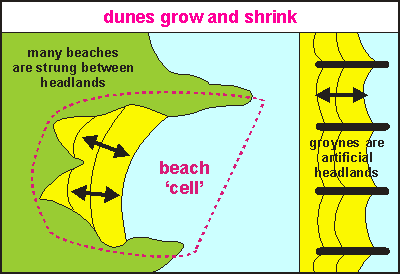 Beaches
strung between natural headlands are very stable and they do not experience
long-shore erosion as much. Groynes (French word for pig's snout) are artificial
headlands, running out into the sea. Between them the wet sand is trapped.
Although groynes increase the quantity of wet sand close to the beach,
they do not improve the beach's self repair mechanism. Not only are they
ugly, they can even cause problems. Beaches
strung between natural headlands are very stable and they do not experience
long-shore erosion as much. Groynes (French word for pig's snout) are artificial
headlands, running out into the sea. Between them the wet sand is trapped.
Although groynes increase the quantity of wet sand close to the beach,
they do not improve the beach's self repair mechanism. Not only are they
ugly, they can even cause problems.
Groynes can be thought of as 'leaking' sand boxes with one open side from which the sand can enter but where it can also be lost. |
Most long-shore sand transport is caused by wind-induced currents. If a wind blows perpendicular to the coast, there are no wind currents. But when it arrives on an angle, a wind induced current occurs. Where the sand is continuously held in suspension, the breaker zone, small currents are able to transport much sand easily. Deeper down, where the sand fails to be stirred by waves, currents have very little effect. The groyne thus prevents the sand from leaving its 'cell'. It works so well that groynes are able to starve un-groyned down-wind beaches from the sand they need to survive.
Groynes accumulate wet sand (up to about 2.5 times their length) so that they have the tendency to lay beaches flatter. Although exposing more sand during low tide, they could decrease the amount of sand able to dry in the wet zone. Groynes do not protect against extreme events and are likely to lose all their sand when these occur.
One would be tempted to make groynes as long as one could, extending far into the sea but that could cause other problems like jetties do.
Note that groynes do give extra protection but the dunes behind them
never seem to accrete and move seaward. In almost all cases the beach needs
to be renourished regularly, which proves that groynes do not fix the original
cause of erosion.
Note also that groynes used to deflect currents from the shoreline,
such as for deflecting tidal currents in current channels, work very well.
Jetties
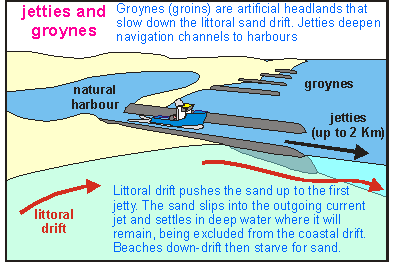 Jetties
are long dams or groynes extending into the sea for hundreds to thousands
of metres. They are designed to make harbour entrances navigable for large
ships. The idea is that the current of the outgoing tide becomes strong
and focussed enough (a jet) to gouge a deep entrance channel between the
jetties. Jetties
are long dams or groynes extending into the sea for hundreds to thousands
of metres. They are designed to make harbour entrances navigable for large
ships. The idea is that the current of the outgoing tide becomes strong
and focussed enough (a jet) to gouge a deep entrance channel between the
jetties.
The problems these structures cause are well documented. In case of a substantial coastal sand drift, the jetties act as a sand sink, starving beaches down-drift from sand. By far, most of the sand in littoral sand drift is moved in the shallow breaker zone. As it encounters the jetty, rip currents and outgoing tide currents suck the sand down into deep water where it remains for a long time until storms slowly move it back towards the shore. The down-drift beaches are then starved from the sand they need to survive. Sand banks will develop from the accumulated sand, hindering shipping. Is it possible to design structures that will provide all the benefits without the draw-backs? |
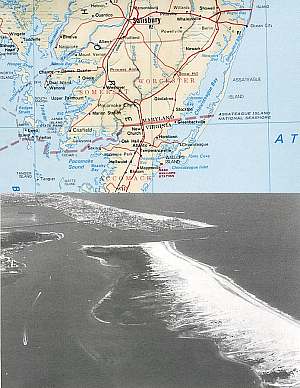 |
The loss of Assateague Island south of Ocean City, USA
(top right corner of map) is a classic example of sand starvation caused
by jetties.
Assateague Island is a long and narrow barrier island that was once inhabited by holidaymakers. Behind the island lies a large lagoon or natural harbour. Barrier Islands usually lack a healthy dune structure because they are usually created by overwash: during large storms, waves wash over the island, depositing sand which stays behind. Wind-borne accretion is also present but less prominent. Ocean City was able to grow after it was linked to the mainland by a railroad bridge in 1880. During a large storm in 1933, an inlet appeared south of Ocean Beach at the weakest point. The city then decided to convert it into an important harbour entrance by constructing jetties. The jetties further starved Assateague Island, which, in the meantime had become uninhabitable. Even though the groynes and jetties trap so much sand in favour of Ocean City, its northern beaches still need renourishing. Photo Stephen P Leatherman, from Cornelia Dean's book Against the Tide. |
Breakwaters
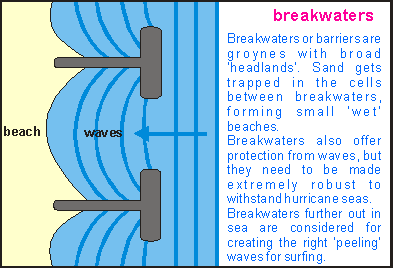 Breakwaters
are groynes with a sea wall or a sea wall with openings. They are very
effective at retaining sand to form wet beaches. Particularly popular for
lakeside resorts, they are able to retain man-made beaches where none existed
before. Lakes do not have tides nor do they have large waves. So dunes
cannot develop and natural beaches remain small. Sand brought in to create
an artificial beach is easily lost to deeper water but breakwaters help
to retain it. Breakwaters
are groynes with a sea wall or a sea wall with openings. They are very
effective at retaining sand to form wet beaches. Particularly popular for
lakeside resorts, they are able to retain man-made beaches where none existed
before. Lakes do not have tides nor do they have large waves. So dunes
cannot develop and natural beaches remain small. Sand brought in to create
an artificial beach is easily lost to deeper water but breakwaters help
to retain it.
In the ocean, breakwaters are easily destroyed by storms. They need to be large and sturdy and would be enormously expensive when constructed to last. |
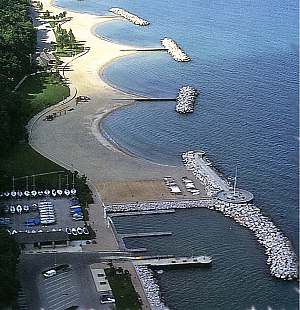 |
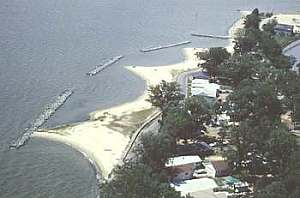 |
Artifical surfing reefs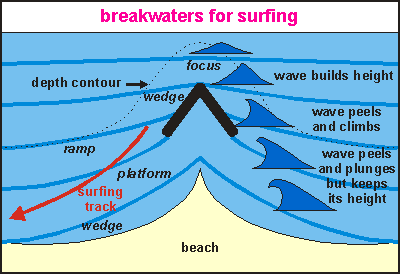 Using
computer models, scientists are now able to design structures in the sea
that pile the sand up in such a way that it creates the ideal conditions
for surfing. In the accompanying diagram a hypothetical structure is placed
in front of the beach to show the ideas behind it. Using
computer models, scientists are now able to design structures in the sea
that pile the sand up in such a way that it creates the ideal conditions
for surfing. In the accompanying diagram a hypothetical structure is placed
in front of the beach to show the ideas behind it.
The good surfing beaches of the world have a number of things in common, described in surfers jargon. The parallel wave fronts arriving at the coast need to be deflected on an angle over a promontory or focus. This is located exactly where the wave starts to build up height because it is entering shallow water. Running along the side of the promontory, which has a slope underneath (the wedge), the wave is pushed up further than it normally would. This rising causes the wave to peel at only one place but as it proceeds towards shallower water over the ramp, the wave peels further and further, while keeping its height. Finally it comes to grief along the wedge provided by the beach. Surfers follow a track on an angle towards the beach. They can swim back towards the wedge in sheltered water and much fun is to be had by all. |
A breakthrough in its design is that the entire structure remains invisible, about a metre below the low tide. Rather than transporting masses of beach sand with fossil fuel, the relatively small artificial reef uses the energy of waves to transport the sand.
Although such structures may attract business while protecting only a small part of the beach, they do not take away the underlying causes of beach erosion: wind broken by high-rise buildings and pollution of the water. They could also be shredded by the first major storm, covering the beach with millions of strands of black, undegradable polypropylene.
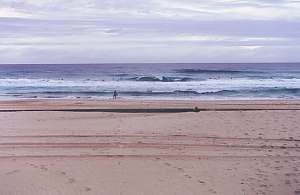 At this point in time, the reef was only 80% complete, lacking its third storey. It appears to have survived the recent storm, which halted progress. Resident surfies say that nothing much has changed. The beach shows no signs of widening. Estimated cost 7 million A$. In the right column some conversation overheard on the Net. |
Sorry guys, I hate to be the one to grouch on this whole
topic but I don't think I am the only one who thinks this way. I live on
the beach at Surfers and have been eagerly awaiting the arrival of supposed
perfect waves but have been severely disapointed. Every time I look at
the progress report about the artificial reef I see the same $#@*'n 80
percent complete. When is the damn thing going to be finished and what
is holding up the progress?? Surely it can't be because of too much swell
activity because I wouldn't be the only one saying that the size has been
consistently small this summer. The only solace I've recieved is from the
perfectly placed sand pump in front of my units which filled the gutter
and produced some nice waves for a while. I just hope that the gentlemen
constructing this reef actually know what they are doing because if they
fail, it doesn't take a genius to figure out that the council will never
fund any more of these projects. Mr Reef please produce the goods that
you know we want!
----------------- We had a sick session on the reef. It was pumping, the waves were doubling up on the bags and barrelling on the first section just because of the reef. I reckon that when the sand settles around the bags, the place will be the the bomb (actually, I'd say it was the bomb yesterday already). Keep up with the good work. |
| The continuing saga.
In the beginning of May 2000, a large storm carved out most of the beach at Surfers Paradise, and other beaches all along the west coast of Queensland and New South Wales. Construction of the artificial surfing reef was halted, and the reef's third storey was never completed. The beaches of Surfers Paradise were renourished lavishly. Between 10 and 13 April 2001, cyclone Sose travelled from New Caledonia southward, to collapse in the Tasman Sea. It brought very strong easterly winds, buffeting the west coast again. Most of the beaches suffered considerable damage, and most of the renourished sand disappeared, except where the artificial surfing reef was built. In Noosa the main beach disappeared again almost completely, having been renourished lavishly in 2000. Other beaches around Noosa lost 6m from their dunes. |
For further information, visit:
www.burleighcam.com.au
- A surfers information site with live camera pictures.
www.onthenet.com.au/~jackson/
- Good background information on the reef technology and motivation.
| Mining the sea sand
Society needs large volumes of sand for roading, housing development and construction. Because sand has an excellent ability to stay put, it behaves like an uncompressible medium for driving or building on. Compared to (clay) soil which expands and shrinks with varying moisture content, sand appears rather stable. Unlike limestone, it cannot dissolve in acidic rain water. As an ingredient in construction concrete, clean sand is indispensable.
Its very hard quartz grains and predictable size composition meet all requirements
for making the highest quality concrete. But the slightest pollution from
either softer rock or shell remains or organic matter, renders it less
suitable.
|
From our new insights we have learnt that the amount of sand has little bearing on the health of the dune/beach system. But a minimal quantity of sand should always remain. We've seen that in two places, excessive amounts of sand cause damage to the system:
--previous chapter--next
chapter--